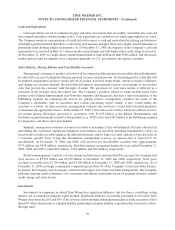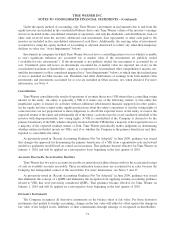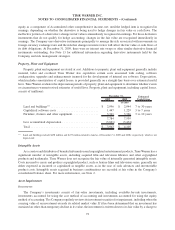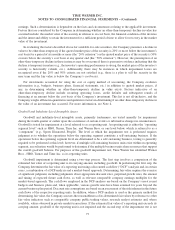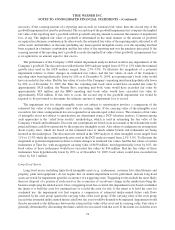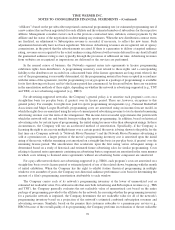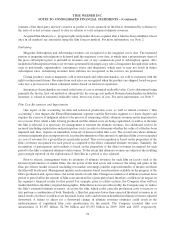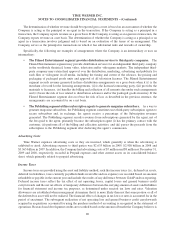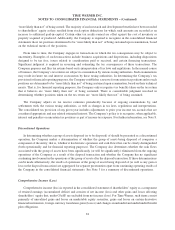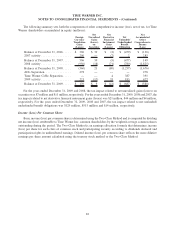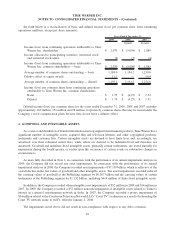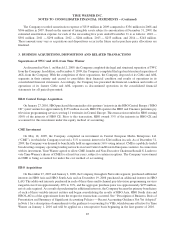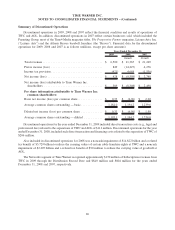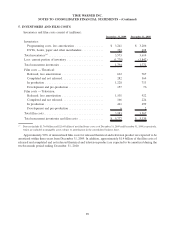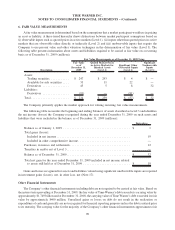Time Magazine 2009 Annual Report Download - page 92
Download and view the complete annual report
Please find page 92 of the 2009 Time Magazine annual report below. You can navigate through the pages in the report by either clicking on the pages listed below, or by using the keyword search tool below to find specific information within the annual report.The determination of whether revenue should be reported gross or net is based on an assessment of whether the
Company is acting as the principal or an agent in the transaction. If the Company is acting as a principal in a
transaction, the Company reports revenue on a gross basis. If the Company is acting as an agent in a transaction, the
Company reports revenue on a net basis. The determination of whether the Company is acting as a principal or an
agent in a transaction involves judgment and is based on an evaluation of the terms of an arrangement. The
Company serves as the principal in transactions in which it has substantial risks and rewards of ownership.
Specifically, the following are examples of arrangements where the Company is an intermediary or uses an
intermediary:
•The Filmed Entertainment segment provides distribution services to third-party companies. The
Filmed Entertainment segment may provide distribution services for an independent third-party company
in the worldwide theatrical, home video, television and/or videogame markets. The independent third-
party company may retain final approval over the distribution, marketing, advertising and publicity for
each film or videogame in all media, including the timing and extent of the releases, the pricing and
packaging of packaged goods units and approval of all television licenses. The Filmed Entertainment
segment records revenue generated in these distribution arrangements on a gross basis when it (i) is the
merchant of record for the licensing arrangements, (ii) is the licensor/contracting party, (iii) provides the
materials to licensees, (iv) handles the billing and collection of all amounts due under such arrangements
and (v) bears the risk of loss related to distribution advances and/or the packaged goods inventory. If the
Filmed Entertainment segment does not bear the risk of loss as described in the previous sentence, the
arrangements are accounted for on a net basis.
•The Publishing segment utilizes subscription agents to generate magazine subscribers. As a way to
generate magazine subscribers, the Publishing segment sometimes uses third-party subscription agents to
secure subscribers and, in exchange, the agents receive a percentage of the Subscription revenues
generated. The Publishing segment records revenues from subscriptions generated by the agent, net of
the fees paid to the agent, primarily because the subscription agent (i) has the primary contact with the
customer, (ii) performs all of the billing and collection activities, and (iii) passes the proceeds from the
subscription to the Publishing segment after deducting the agent’s commission.
Advertising Costs
Time Warner expenses advertising costs as they are incurred, which generally is when the advertising is
exhibited or aired. Advertising expense to third parties was $2.635 billion in 2009, $2.908 billion in 2008 and
$3.365 billion in 2007. In addition, the Company had advertising costs of $7 million and $8 million at December 31,
2009 and 2008, respectively, recorded in Prepaid expenses and other current assets on its consolidated balance
sheet, which primarily related to prepaid advertising.
Income Taxes
Income taxes are provided using the asset and liability method, such that income taxes (i.e., deferred tax assets,
deferred tax liabilities, taxes currently payable/refunds receivable and tax expense) are recorded based on amounts
refundable or payable in the current year and include the results of any difference between GAAP and tax reporting.
Deferred income taxes reflect the tax effect of net operating losses, capital losses and general business credit
carryforwards and the net tax effects of temporary differences between the carrying amount of assets and liabilities
for financial statement and income tax purposes, as determined under enacted tax laws and rates. Valuation
allowances are established when management determines that it is more likely than not that some portion or all of
the deferred tax asset will not be realized. The financial effect of changes in tax laws or rates is accounted for in the
period of enactment. The subsequent realization of net operating loss and general business credit carryforwards
acquired in acquisitions accounted for using the purchase method of accounting is recognized in the statement of
operations. Research and development credits are recorded based on the amount of benefit the Company believes is
80
TIME WARNER INC.
NOTES TO CONSOLIDATED FINANCIAL STATEMENTS – (Continued)


